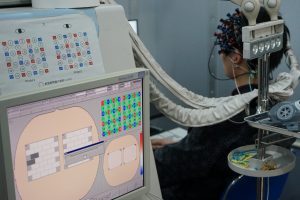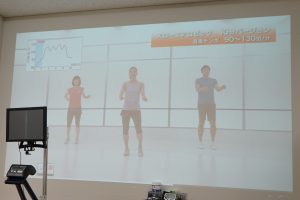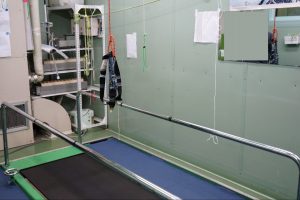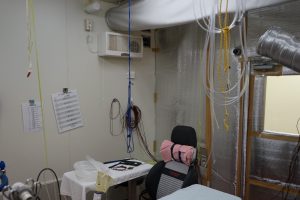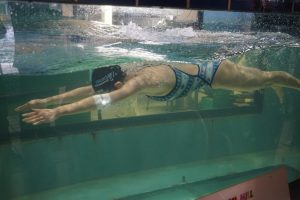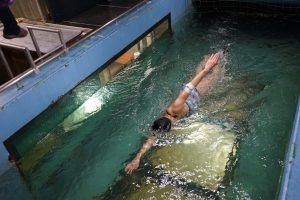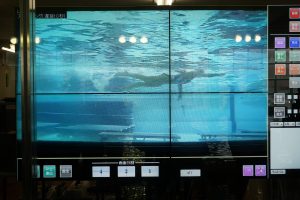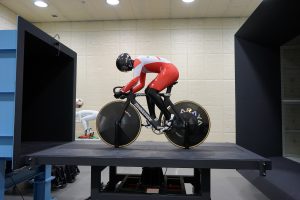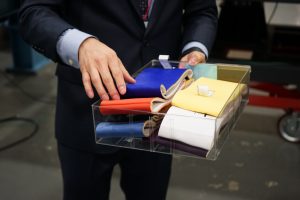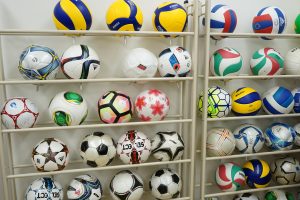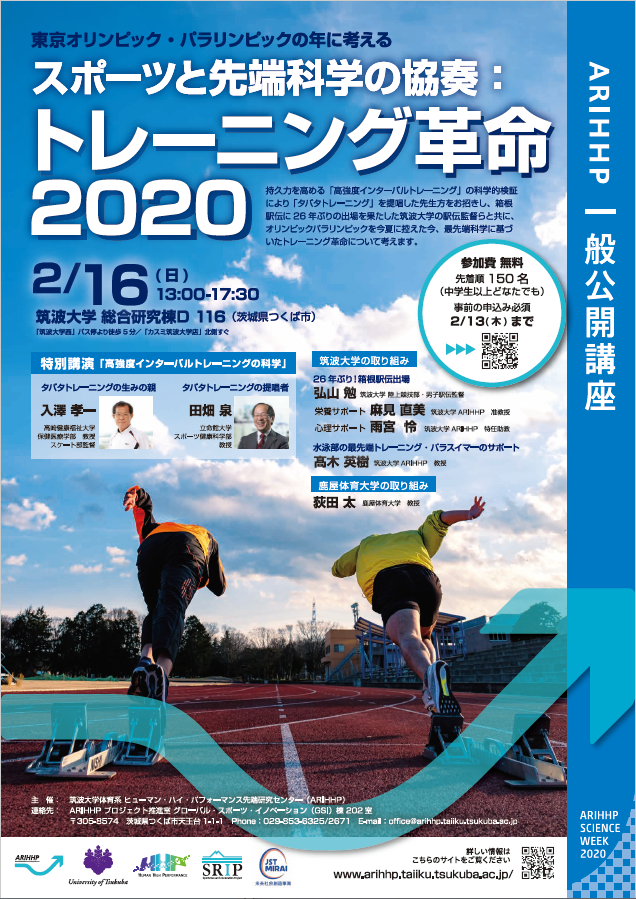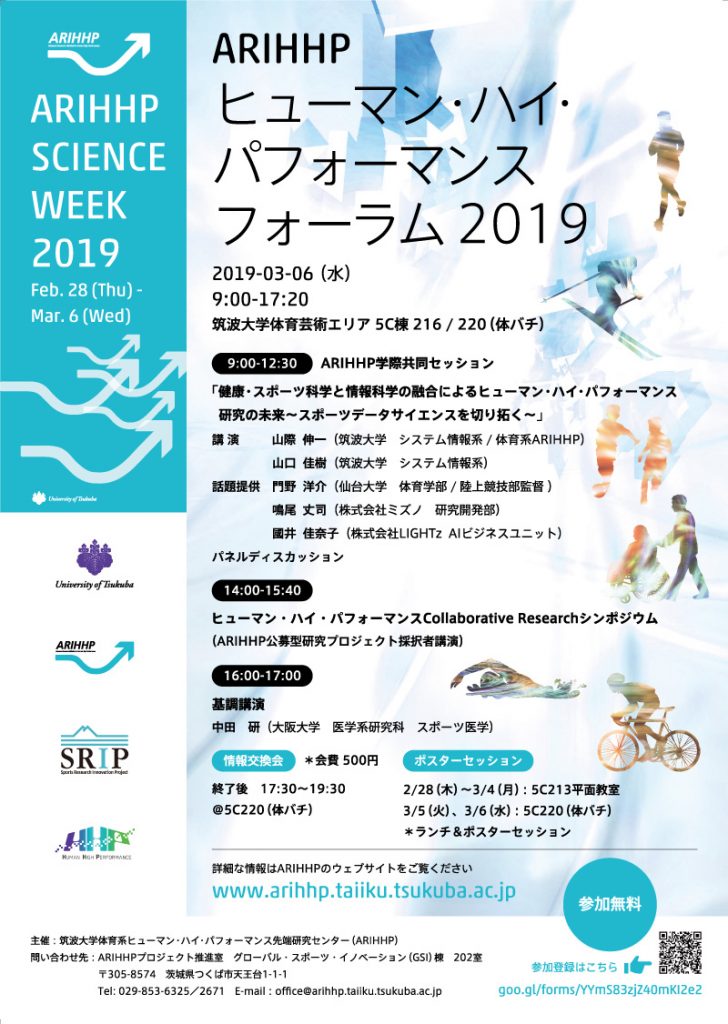2020.03.06
“ARIHHP Science Week 2020” was held
“ARIHHP Science Week 2020” was held at University of Tsukuba on February 16th and 17th, 2020.
We introduce the overview of the event and the research facilities introduced to the media.
For more details about “ARIHHP Science Week”, please reference this page.
Overview
For details about the schedule, please reference the ARIHHP website.
Public Open Lectures February 16th (Sun), 2020
Theme: “Sports and Latest Science for the Year of the Tokyo 2020 Olympic and Paralympic: Training Revolution 2020”
This is the first public open lectures since ARIHHP was established.
At the lectures, there were the special lectures given by Dr.TABATA Izumi, the advocate of Tabata Training, and Dr. IRISAWA Koichi, and the introduction of the activities of the University of Tsukuba and the National Institute of Fitness and Sports in Kanoya.
Participants including a lot of student athletes and coaches exchanged opinions on a training revolution based on latest science.
From the Univesity of Tsukuba, the initiatives of Hakone Ekiden Project were introduced.
The ekiden team participated in the Hakone Ekiden in 2020 for the first time in 26 years.
The faculties in various departments have been supporting the ekiden team.
Students of the Research Lab of Nutrtion independently cook dinner for the ekiden team and analyze the data as the basis of the menu.
They prepared the menu and cooked lunch for the Swiss top athletes when the Swiss athletics women’s relay team and the Swiss triathlon team held the pre-camp in 2019.
Press Conference February 17th (Mon), 2020
Theme: “The Challenge of Sport Science for Tokyo Olympic and Paralympic Games and Beyond”
It was the conference for university and graduate students, researchers, joint research institutions, and media.
Media and researchers interacted through special lectures and ARIHHP’s latest research reports so that sport science could be further disseminated in the future.
At the special lectures, participants actively exchanged opinions on initiatives after the Tokyo 2020 Olympic and Paralympic Games, such as how to implement various elements of sport in society through the Games.
ARIHHP researchers reported the latest research results.
Sport science research has been expected not only to improve athlete records but also to play an important role in society.
Introduction of Research Facilities
After the press conference, the latest research facilities were introduced to the media.
We introduce some of them by department.
For details regarding the three sections and research facilities, please reference here.
Department of MIND
Brain Imaging System, fNIRS
Researchers study the effects of exercise on prefrontal function using functional near-infrared spectroscopy (fNIRS) and Stroop test.
The recent studies have shown that exercise helps maintain and improve not only physical fitness, but also cognitive function.
Researchers have developed the exercise program such as the Slow Aerobic Dance so that people can keep exercise easily in daily life.
Department of BODY
Environmental Chambers
Barometric pressure, temperature, humidity and O2 concentration can be controlled.
The left picture is the Hypobaric Environmental Chamber that can simulate a high-altitude environment (low pressure and low oxygen) up to 8000m above sea level.
Researchers are studying cardiorespiratory stress under hypobaric hypoxic conditions.
The right picture is the chamber that can control the temperature, humidity, and oxygen concentration. Temperature can be precisely controlled from -10 to 45℃.
Researchers are studying strategies aimed at optimizing performance in the heat for the Tokyo 2020 Olympic and Paralympic Games.
Department of TECHNIQUE
Experimental Circulating Water Channel and Environmental Control Tank
This is one of the largest circulating water channels in Japan that can visualize the resistance and flow of water during swimming.
Researchers take advantage of the data here for motion analysis of top athletes and swimsuit development.
The athlete who is the bronze medalist in swimming at the Rio 2016 Paralympic and graduated from University of Tsukuba swam here and the secrets of his speed was studied.
Researchers also contributed to the development of the latest swimsuit for the Tokyo 2020 Olympic Games, “ULTIMATE AQUAFORCE X”.
Poolside Monitor (below grade pit)
This device is useful for training in the pool.
Athletes can check their form by themselves.
Sport Fluid Engineering Laboratory
This laboratory has Circulating-type Low-speed Low-turbulence Wind Tunnel (maximum wind speed is 55m/s, the degree of turbulence is less than 0.1%).
Researchers aim to improve sports performance by developing sports technology and tools.
The research and development of sportwear (cycling wear, jumpsuit for skiing), and measurement and evaluation of aerodynamic forces acting on soccer ball and volleyball has been carrying out at this laboratory.
The cycling wear has been developed for the Tokyo 2020 Olympic Games.
At the PyeongChang 2018 Olympic Games, an athlete of Japanese national team wore a jumpsuit that utilized the research results.
Official soccer balls such as the Bundesliga were developed here.
They also have been researching new ball used in volleyball at the Tokyo 2020 Olympic Games.



